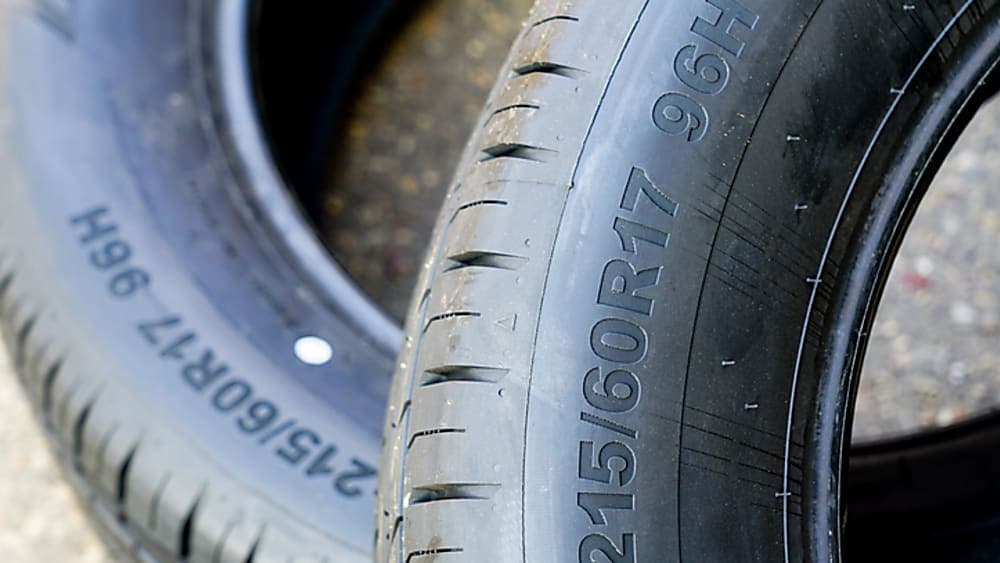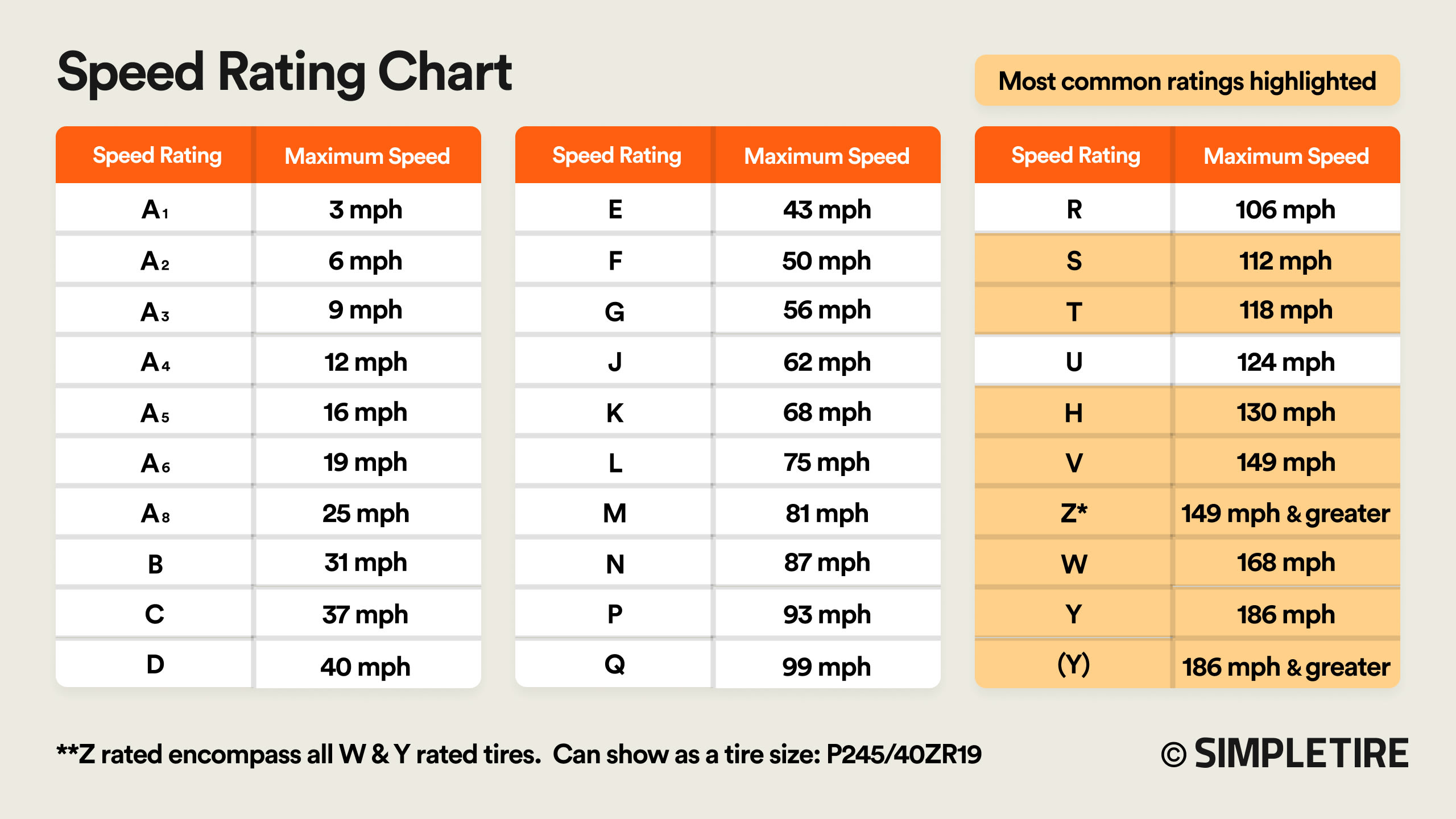tire buying guides
Tire Speed Rating Chart
Speed ratings inform automakers and vehicle owners of the maximum speed capability of their tires. Here’s everything else you should know about tire speed ratings.

Free shipping
Best price guarantee
Special pricing
Financing with Resolve
Easy returns
tire buying guides
Speed ratings inform automakers and vehicle owners of the maximum speed capability of their tires. Here’s everything else you should know about tire speed ratings.


Tires carry coded information that directly impacts your vehicle's safety and performance. Among these codes, the speed rating stands out as a critical specification that many drivers overlook when purchasing new tires.
A tire's speed rating represents more than just a number on the sidewall — it determines how your vehicle handles, stops, and performs under various driving conditions. This alphabetical system, ranging from A to Y, helps drivers select tires that match their vehicle's capabilities and their own driving needs.
Understanding speed ratings becomes essential when replacing tires or upgrading your vehicle's performance. The right speed rating ensures your tires can safely handle the demands you place on them, whether commuting to work or taking that weekend road trip.
A tire speed rating tells you the maximum speed a tire can safely handle when properly inflated and under load. This crucial safety specification appears as a letter on your tire sidewall and represents the highest sustained speed at which the tire can operate without compromising its structural integrity or performance capabilities.
Speed ratings use an alphabetical system that ranges from A (the lowest) to Y (the highest), with each letter corresponding to a specific maximum speed. These ratings were developed in Europe to help ensure tire safety at standardized speeds, particularly in response to the high-speed driving conditions on Germany's Autobahn. The system has since become a global standard that helps drivers and technicians match tires to vehicle requirements.
The rating appears after the load index number in your tire's size code. For example, in the tire size 205/55R17 91V, the "V" represents the speed rating, indicating this tire can safely sustain speeds up to 149 mph. This placement makes it easy to identify once you know where to look, though many drivers never realize this important safety information sits right on their tire's sidewall.
Speed ratings encompass more than just maximum velocity — they also indicate a tire's overall performance characteristics. Higher speed-rated tires typically feature:
The development of speed ratings reflects the evolution of vehicle performance and highway systems worldwide. As manufacturers continue to produce faster, more capable vehicles, tire technology must keep pace to ensure safety remains paramount at all operating speeds.
Identifying your tire's speed rating involves checking specific locations on your vehicle. On the tire sidewall, you'll find a sequence of numbers and letters — the speed rating is designated by the last letter. This quick inspection provides the information needed to ensure compatibility with your vehicle.
Your vehicle's owner's manual is another valuable source. It details the recommended speed rating, aligning with the vehicle's design for optimal safety and performance. Additionally, check for a label on the driver's door jamb, which often lists tire specifications, including the speed rating, to guide your purchasing decisions.
You might also find this information inside the glove box door or gas tank hatch, where some vehicles have stickers with tire details. Understanding your tire service description further clarifies these markings, ensuring you choose tires that perfectly match your driving conditions and vehicle requirements.

Understanding tire speed ratings ensures you choose tires that align perfectly with your vehicle's capabilities. Each letter in the speed rating represents a specific maximum speed, tailored for different vehicle types and uses.
The ZR designation signifies tires designed for speeds above 149 mph, ensuring high-speed reliability. For example, a tire marked as P275/40ZR17 93W can manage speeds up to 168 mph, while 93Y accommodates up to 186 mph. This classification highlights the sophisticated engineering behind high-speed tire technology.
Speed ratings go beyond indicating top speed—they play a vital role in your vehicle's handling, temperature management, and overall efficiency. [Selecting the right speed rating] ensures that your tires can handle the specific demands of your driving environment, providing stability and assurance on the road.
Tires with higher speed ratings often deliver increased traction and precision. This results in better control during challenging maneuvers and more effective braking, enhancing road safety. These tires typically feature robust sidewalls, which contribute to sharper cornering and a more engaging driving experience.
While high-performance tires offer these benefits, they also come with trade-offs. The specialized materials used can lead to reduced tread longevity, and the firmer construction might impact ride comfort. Vehicles are engineered with specific speed ratings to ensure optimal safety and function, so choosing the correct rating aligns your tires with your vehicle’s intended performance.
Selecting the correct speed rating involves understanding both your vehicle's requirements and your driving conditions. It's crucial to choose tires that meet or exceed the speed rating recommended by your vehicle manufacturer, ensuring safety and optimal performance.
Different types of tires present unique performance characteristics, influencing how speed ratings should be considered:
Grasping how speed ratings and load index numbers interact is vital for tire safety and performance. These two metrics complement each other, defining a tire's capacity in terms of speed and weight. It's crucial to confirm that both ratings align with your vehicle's specifications to maintain optimal control and safety.
The load index specifies the maximum weight a tire can sustain when inflated correctly. Found next to the speed rating on the tire sidewall, it offers insights into the tire’s weight-bearing limits. Ensuring that the load index matches your vehicle’s needs helps prevent issues like tire stress and potential failure, especially when carrying passengers and cargo.
A tire’s speed potential is contingent upon it not being overloaded. Surpassing the load index can diminish the tire's speed capability, leading to risks such as overheating. Recognizing this balance aids in selecting tires that fit your vehicle and driving conditions seamlessly.
When choosing tires, ensure both the speed rating and load index meet or exceed the guidelines provided by your vehicle’s manufacturer. This ensures the tires perform effectively under various conditions. Overloading a tire can affect its ability to handle speed, compromising safety.
By respecting the relationship between speed ratings and load indexes, drivers can make informed choices that boost safety and performance.
Using tires with varying speed ratings is not ideal for maintaining vehicle safety. Uniformity in tire speed ratings across all wheels promotes consistent handling and braking, essential for stability. This consistency helps ensure a smooth and controlled driving experience.
If mixing is absolutely necessary, place the tires with lower speed ratings on the front axle. This arrangement mitigates the risk of oversteer, where the rear tires lose traction first. However, it limits your vehicle's top speed to that of the lowest-rated tire, potentially affecting overall performance.
For optimal results, aim to match all four tires. This approach guarantees balanced performance, aligning with how the vehicle was engineered. Consistent tire choice enhances safety and control, providing a reliable and predictable ride.
Driving beyond a tire's speed rating may cause significant issues. At excessive speeds, heat buildup within the tire can lead to failure. This heat can result in tread separation, compromising the tire's structure and increasing the chance of blowouts.
Performance aspects, such as handling and braking, degrade when a tire is overstressed. The tire's road grip diminishes, affecting your command over the vehicle. Additionally, the tire may lose its shape, further impairing its effectiveness and reliability.
Moreover, exceeding speed ratings can disrupt your vehicle's safety systems. Features like traction control depend on the tire's performance to function correctly. When speed thresholds are surpassed, these systems may not work as intended, heightening the risk of accidents. Adhering to speed ratings ensures your tires operate safely and efficiently.
Understanding tire speed ratings empowers you to make informed decisions that keep your vehicle performing safely at its best. The right speed rating ensures your tires work in harmony with your vehicle's capabilities, providing the stability and control you need for every journey. When you're ready to find tires that match your vehicle's specifications perfectly, we make it easy to shop for tires online and find the best deals with the confidence that comes from knowing exactly what your vehicle needs.
A tire’s speed rating indicates the optimal speed that the tire can safely maintain over time. In short, it’s the fastest speed a tire can handle before it no longer performs as designed. The higher the speed rating, the better control and handling you’ll have at higher speeds.
Yes, tire speed rating matters because a higher speed rating usually means you will have better control and handling at higher speeds — and that the tire can take the extra heat that comes with high-speed driving. As a general rule, tires with higher speed ratings also handle better at slower speeds.
Search By